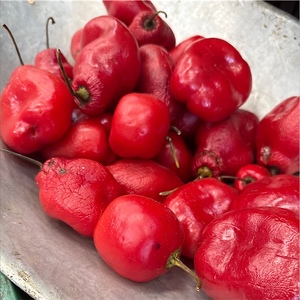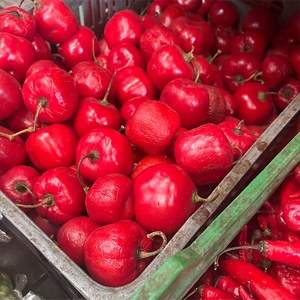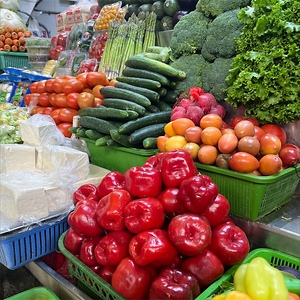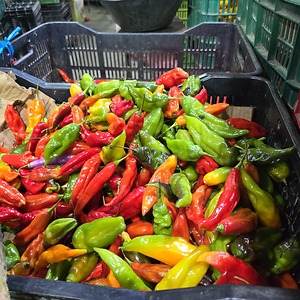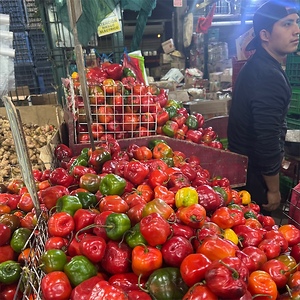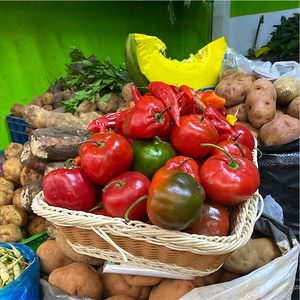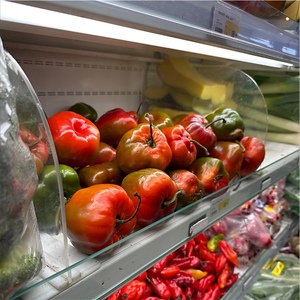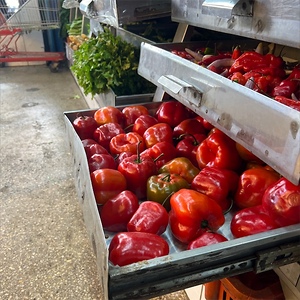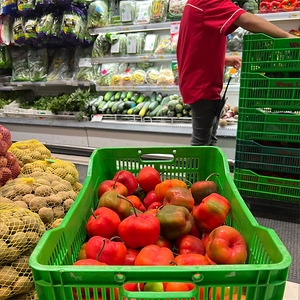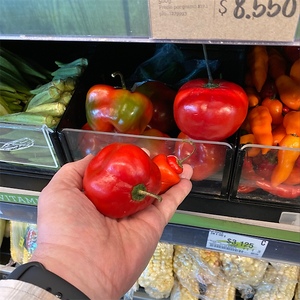

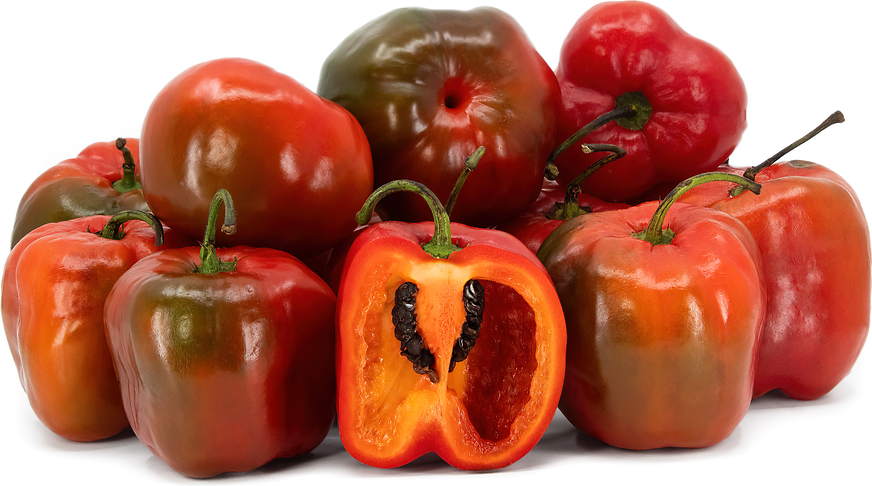
Rocoto Chile Peppers
Estimated Inventory, lb : 0
Description/Taste
Rocoto chile peppers vary in size and shape, depending on the specific type and growing conditions, and average 5 to 8 centimeters in diameter. The pods typically appear in bulbous, block-like shapes, similar to bell peppers, but are also found in oval to pear shapes. The pepper’s skin is smooth, taut, glossy, and thick, topped with a small green cap and a fuzzy, dark green stem. The surface also ripens from green to shades of red, orange, yellow, or variegated hues. It is rumored in Peru that the smaller Rocoto peppers typically have the hottest taste, but this is mostly lore among market vendors. Underneath the skin, the flesh is thick, dense, and crisp with a succulent consistency. The flesh’s color tends to resemble the pod’s exterior hues but is mostly a shade or two lighter. Rocoto chile peppers also encase a hollow central cavity filled with veining and tiny, round, black-brown seeds. They are one of the few peppers with black-colored seeds, which are edible when dried and ground into a spice. Rocoto chile peppers are consumed raw or cooked and emit a light, fruity, herbal, sweet, and grassy taste followed by an intense spice. The spice lingers on the palate and creates a steady burn.
Seasons/Availability
Rocoto chile peppers are available year-round.
Current Facts
Rocoto chile peppers, botanically classified as Capsicum pubescens, are a South American variety belonging to the Solanaceae or nightshade family. The blocky peppers are native to the Andes Mountains and have been extensively used as a medicinal and culinary ingredient since pre-Columbian times among civilizations throughout the western regions of South America. Rocoto peppers are a spicy variety, ranging from 30,000 to 100,000 SHU on the Scoville scale, with the hottest peppers sharing a heat similar to a low-spiced habanero. The name Rocoto is a general descriptor encompassing many different types of peppers with similar flavor, shape, and heat. It has been estimated that Peru may be home to over 200 kinds of Rocoto chile peppers, and each variety will vary in coloring from red, orange, and yellow to variegated hues. Rocoto chile peppers are known as Locoto in Bolivia and Argentina, Caballo in Guatemala, Cera, Ciruelo, and Malinalco in Mexico, and Luqutu and Rukutu in Aymara and Quechua, Indigenous languages spoken throughout the Andes Mountains. Throughout history, Rocoto chile peppers have been a foundational flavoring in hot sauces and salsas in South America, and the black-seeded peppers have remained a popular spice into the modern-day. They have also expanded into international markets as a specialty pepper. Rocoto chile peppers are grown in home gardens and are commercially produced throughout South America. The peppers are valued for their grassy-sweet flavor, fleshy nature, and robust spice and are incorporated into a wide array of fresh or cooked preparations.
Nutritional Value
Rocoto chile peppers have not been extensively studied for their nutritional properties. Some research notes that peppers may be a source of fiber to regulate the digestive tract, phosphorus to repair tissues, and vitamin C to strengthen the immune system. Chile peppers also provide vitamin A to maintain healthy organ functioning, iron to develop the protein hemoglobin for oxygen transport through the bloodstream, calcium to build bones and teeth, and other nutrients, including thiamine, riboflavin, niacin, folate, and vitamin E. Rocoto chile peppers contain capsaicin, a chemical compound that triggers the brain to feel the sensation of spice or heat. Capsaicin has been shown to have anti-inflammatory properties and to help stimulate the digestive tract. The pepper’s seeds and flesh are sometimes ground into a powder and rubbed on the gums to reduce pain in the mouth.
Applications
Rocoto chile peppers have a sweet, subtly fruity, and fiery taste suited for raw and cooked preparations. The variety is mainly consumed fresh or cooked, and the veins and seeds can be removed before eating to reduce heat. It is important to note that capsaicin oil from handling the pepper can linger on the skin and irritate the eyes and nose, so gloves are recommended to be worn when touching the peppers. Rocoto chile peppers can be diced into salsas, blended into creams, hot sauces, and pastes, or infused into marinades and dressings. The peppers can also be used whole or sliced into pieces and tossed into soups, stews, and chowders. In Peru, Rocoto chile peppers are often used for their lingering burn and added to ceviche, the country’s national dish. The peppers are also used to make papa a la huancaina, or boiled potatoes slathered in a thick, creamy sauce, and pachamanca, a traditional cooking process in an underground oven used throughout the Andes Mountains. Try incorporating the peppers into stir-fries, serving them in sauces for grilled meats, or pickled to develop a sweet and tangy flavor. In Bolivia, Rocoto chile peppers are stuffed into empanadas, blended into salad dressings, or used in variations of pique macho, a stir-fry served over fries or rice. Beyond fresh preparations, Rocoto chile peppers are sometimes dried, but their thick nature makes it challenging to remove moisture. Once dried, the pods are ground into a powder and used as a flavoring spice. The black-brown seeds are also ground into a powder and sprinkled into dishes, similarly to black pepper. Rocoto chile peppers pair well with herbs such as oregano, cilantro, parsley, and huacatay, cheeses such as Oaxaca, parmesan, and cotija, aromatics including garlic, tomatoes, and onions, and meats such as poultry, beef, and pork. Whole, unwashed Rocoto chile peppers will keep up to one week when stored in a plastic bag in the refrigerator.
Ethnic/Cultural Info
Rocoto chile peppers are featured in two well-known legends throughout Peru. The first tale is a variation of a pre-Columbian creation story. Mama Rayhuana, also known as Mama Rawray, traveled with Ayar Ucho and his two brothers. After the death of his brother, Ayar Ucho became ill with a tumor or swollen thyroid. His wife, Mama Rayhuana, also became sick with the same issue. Ayar Ucho eventually passed away from the sickness, and in her grief, Mama Rayhuana ripped the swollen abscess from her neck and threw it to the ground. As she threw it to the ground, the abscess became the Rocoto chile pepper, and some sources claim the name Rocoto stemmed from the Quechua word for “to throw.” The second legend recounts the origins of the famous dish Rocoto rellenos. The dish was developed in Arequipa and is comprised of Rocoto chile peppers stuffed with minced ingredients such as herbs, spices, olives, eggs, peanuts, and meat. Chef Manuel Masías is credited with creating Rocoto rellenos, and legend has it that he developed the dish to save his daughter's soul. Masías’s daughter, Delphine, passed away at a young age. The chef went to the devil and begged him to bring his daughter back. He made a deal with the devil and prepared a banquet. The primary dish served at the banquet was Rocoto pepper stuffed with various ingredients, and it is said that the devil loved the meal so much that he allowed the soul of Masías’s daughter to return to Earth. Since its creation, Rocoto rellenos has become a signature dish of the Arequipa region and Peru.
Geography/History
Rocoto chile peppers are native to South America and are descendants of species that have been growing wild since ancient times. The exact history of the variety is unknown, but peppers belonging to Capsicum pubescens arose from regions of the Andes Mountains now located in modern-day Peru and Bolivia. Rocoto chile peppers are thought to have pre-Columbian origins, and some sources note that remains from the species have been discovered in tombs dating over 2,000 years in Peru. The peppers thrive in mild and cooler climates, allowing them to be cultivated in mountainous regions, and over time, they expanded in production to regions bordering the mountains and jungles in South America. Rocoto chile peppers were also spread to other areas worldwide, including Mexico, where they are commercially grown in Guerrero, Queretaro, and Chiapas. Today, Rocoto chile peppers are cultivated and sold in South America, mainly in Peru, Chile, Bolivia, Ecuador, Colombia, and Argentina, and are also grown on a smaller scale in specialty and home gardens worldwide. In Peru, the variety is planted in Arequipa, Pasco, Lambayeque, Ica, Huánuco, and Junín. The Rocoto chile peppers featured in the photograph above were sourced through markets in Lima, Peru.
Recipe Ideas
Recipes that include Rocoto Chile Peppers. One
| Que Rica Vida |
|
Stuffed Peruvian Rocoto |
| Mind Body Green |
|
Peruvian Artichoke Heart Salad |



